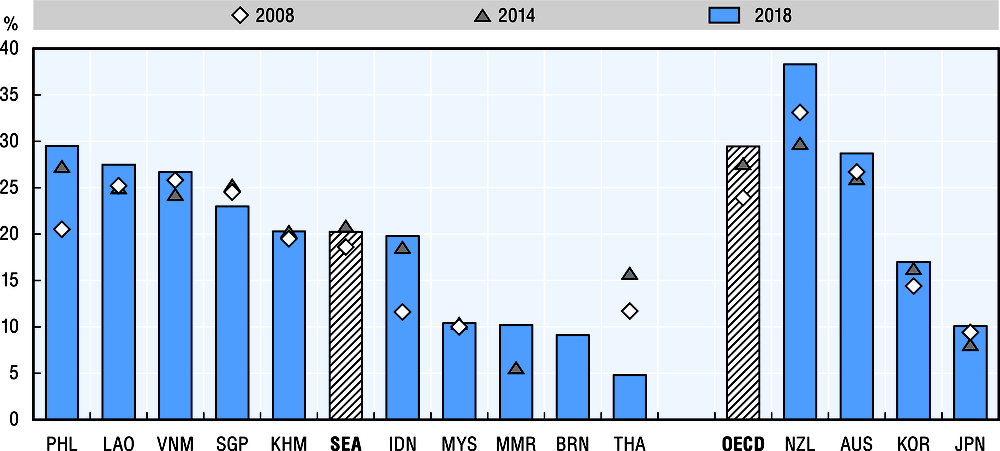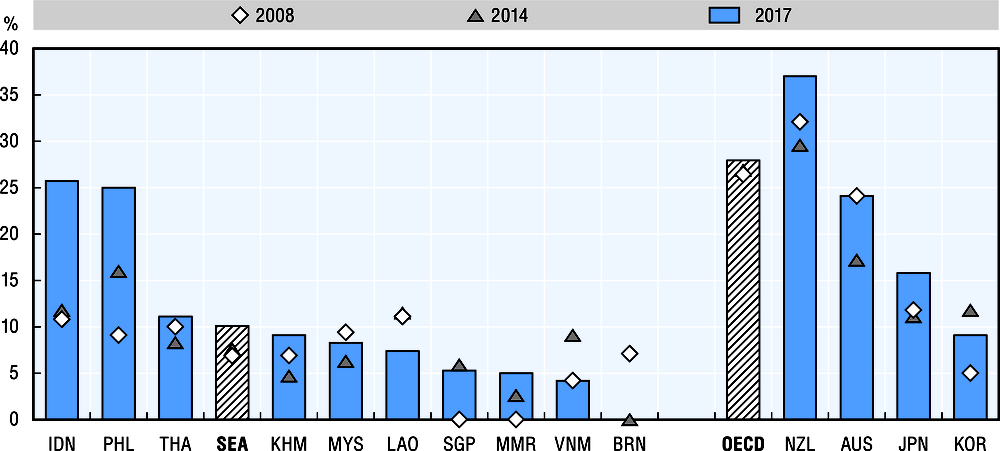Achieving gender parity in parliaments and government is crucial to ensure that women’s perspectives are integral to public decision-making, being reflected in government policies and strategies. In adopting the UN Sustainable Development Goals (SDGs), SEA countries have committed to achieving women’s full and effective participation and equal opportunities for leadership at all levels of public decision making. Yet women’s political representation in SEA countries has hardly increased over the past decade. Women are still under-represented, filling only one-tenth of ministerial positions and one-fifth of parliamentary seats on average.
Enhancing women’s full participation in political leadership entails a comprehensive set of measures that tackle the patriarchal attitudes and cultural norms around women’s leadership, as well as institutional incentives encouraging women’s participation. Mentoring schemes, media training, and financial support for campaigns play a key role in supporting women to build the capacity, network and financial stability to run as candidates. Quotas (at party and legislative levels) are also important, as well as sound accountability and monitoring mechanisms to ensure implementation.
On average, women held 20% of parliamentary seats in SEA countries in 2018, a 1.7 p.p. increase compared to the 2008. Overall, the direction of change has been positive, with notable increases of 9 p.p. in the Philippines and 8 p.p. in Indonesia during that time period. Only Singapore and Thailand witnessed a decline in women’s parliamentary representation between 2008 and 2018, by 1.5 p.p. and 6.9 p.p. respectively.
There is a great deal of variation in the region, however. Women’s parliamentary representation ranges from 30% in the Philippines, 28% in Lao PDR and 27% in Viet Nam to a mere 5% in Thailand and 9% in Brunei Darussalam.
These figures highlight why quotas are only one part of the policy response required. They work to ensure a minimum level of women’s representation in parliament, but do not always extend beyond that. Viet Nam, Indonesia, Thailand and Korea all have some form of statutory and/or legislated party quotas. The Philippines and Singapore have voluntary political party quotas. Yet, of these countries, the change in women’s representation between 2008 and 2018 has ranged from -6.8 p.p. in Thailand to +9 p.p. in the Philippines. Viet Nam and Korea saw hardly any change at all during this time; in Singapore, the percentage dropped slightly. Lao PDR, which does not have any quotas, has the second highest proportion of women in parliament (28%).
When it comes to ministerial representation, most SEA countries have a larger hurdle to overcome. On average, 10% of ministerial posts were filled by women in 2017. Only in Indonesia and the Philippines is the percentage of women ministers similar to the OECD average of 28%. These two countries have a similar proportion of women ministerial representation as New Zealand and Australia amongst the OECD countries in the region, whereas most SEA countries are more in line with Japan (16%) and Korea (9%). Brunei Darussalam is the exception, with zero women ministers.
Since 2008, the proportion on average has increased by 3 p.p., suggesting hardly any change over the decade. Two countries stand out from this trend, however – Indonesia and the Philippines. Both countries have witnessed an increase of 15-16 p.p. of women ministers between 2008 and 2017s.
To date, no SEA or OECD country has legislated gender quotas for executive appointments.


